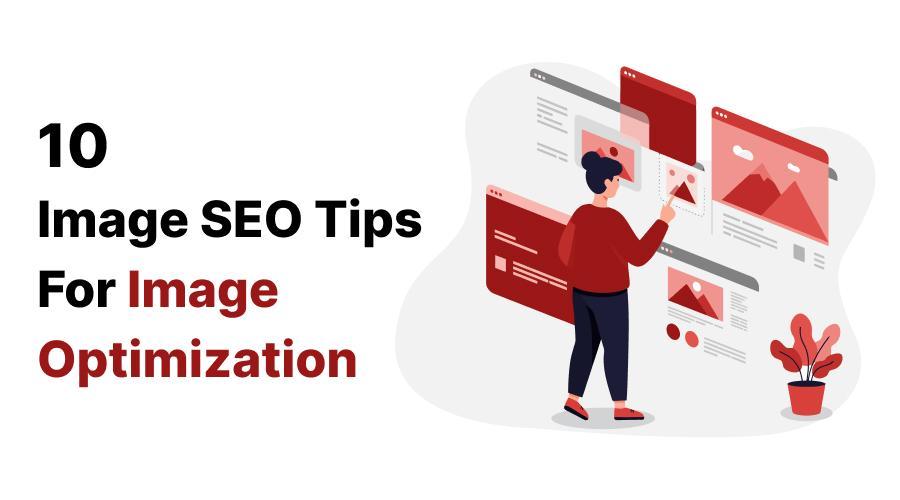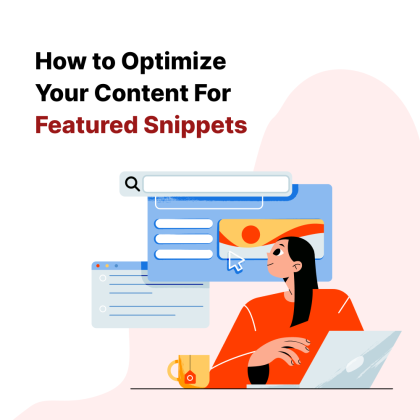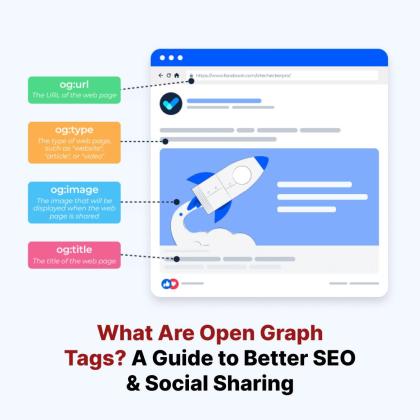10 Image SEO Tips for Better Image Optimization

In this visually driven world, Images act as the decorative piece for any website. They are strong elements to increase the number of visitors and improve user engagement. Their strategic optimisation has a great impact on the overall ranking of your site in your SEO strategies.
Attractive images make the visitors go further and read the content, and eventually explore the products and services. But it is important to keep in mind that just throwing any image on the website won't work for you. To truly get the best results, you need to do image optimisation. If you are not aware of image SEO, this guide is for you. Today, we are exploring the top 10 tips for image optimisation.
What is Image SEO?
Image SEO refers to the process of optimising images for search engines to boost the website's visibility and traffic. It includes numerous techniques, such as aligning images with the content, properly naming files, adding alt texts and captions, and optimising file size to ensure faster loading.
Image optimisation increases the ranking of your site and makes it easy for your target audience to find your brand, product or services. Image SEO is crucial in all local SEO strategies, as evidenced by the fact that 22% of Google’s total searches are image searches. If you are planning to opt for image SEO for improving your company’s online presence, you can contact any reputed digital marketing company.
Importance of Image SEO
Image SEO tips mainly focus on enhancing the visual presence of the site, whether they are on the landing page or a blog post. They make your webpage more attractive to the visitors. Your audience can find the content easier to read because of the images.
An SEO company is a skilled team of experts who perform image optimisation tasks for startups and businesses, as it gives the finest results. If you want to understand the importance of image SEO in more detail, we need to dive a bit deeper! The next section is about the advantages of Image SEO.
Main Advantages of Image SEO
Here, we have covered some main advantages of image SEO for online businesses:
1) Higher Ranking in Google Image Search
There are higher chances of SEO optimized images appearing top of the search engines. Even if your target audience is not searching directly for your brand. The images with descriptive alt text and file names provide context to search engines, helping them to navigate the content of your website and ultimately show your images top of the ranking.
2) Increased Organic Traffic
When any user finds your image at the top of the image search result, they click on it, and they are directed to your company’s website. This elevates the organic traffic on your website. This is only possible by following the best image SEO tips so that your well-optimised images increase the chances. And your user might explore your website further, like some content, and share it with others. It will indirectly positively impact your search engine rankings.
3) Enhanced User Experience
Quality and relevant images are a great part of local SEO strategies. It helps you to make your website visually pleasing and easier to navigate. Your site can simplify text-heavy content for the convenience of the readers. When a potential customer reads your content, the images can simplify the complex concepts and increase the possibility of the visitor reading the whole content and staying longer on the website. All this translates to a good user experience and ultimately better engagement.
4) Better Branding
If you use consistent and SEO-friendly images across all platforms, it will result in making your brand more recognisable to users. For that task, you can connect with the best SEO company to manage your image optimisation tasks. Consistent and high-quality images will ensure that the users trust your brand and buy your products or services. Additionally, images can act as a powerful storyteller for portraying your brand’s values; with this, you can connect with your target audience on an emotional level.
5) Increased Social Media Sharing
Eye-catching images are more likely to be shared on social media, hence enhancing your reach even further. So, image optimization works as an important aspect of your local SEO strategies. For a better outcome, you can optimize your images, keeping in mind the requirements of different social media platforms.
Top 10 Image Optimization Tips For Your Website
We have seen how important image SEO can prove to be for any startup, business, or organization. Now we will move further and see how to implement image SEO in the most fruitful way. With thorough research, we have come up with the top 10 tips for image optimisation:
1) Focus on Using Original Images
Try to use original images as much as possible instead of using stock photos. Search engines prefer the original content, as they are part of the best SEO strategies. However, directly using stock photos does not affect your ranking, but users like the original content, which makes them remember your unique images, potentially your product, and your brand.
2) Use Descriptive File Names and Alt Text
It is one of the crucial image SEO tips to always name your image file instead of using a boring and generic name like “IMG_1234.jpg”. You can always name your file with attractive words that align with the picture. This helps the search engines to know beforehand what's in the picture. Also, provide alt texts for the image, which ensures search engines understand the image better and improves accessibility to the users.
3) Opt for the Right Image Format
There are various image formats; choose the right one according to the image. The image formats that are supported by Google are JPEG, PNG, WebP, GIF, BMP, and SVG. JPEGs are the best image SEO tips for photos, and PNGs work well for graphics with sharp edges. WebP is the modern image format that works well for better compression and quality.
4) Compress the Image
Try to compress the image without sacrificing the quality. The large files will take more loading time and slow down your website. This will affect the overall user experience. There are numerous image optimisation tips and tools available that compress the image quality without compromising the quality, like TinyPNG, JPEGmini, Imagecompressor, and others.
5) Use Responsive Image Design
Your main SEO strategy goal should be to provide a seamless experience to your users whenever they come to your website. During the implementation of your SEO strategies, you should always ensure your website is mobile-friendly and responsive. So your users won't find any difficulty if they are accessing it through any browser or device. The same strategy is applied to image SEO; you should consider that the images are properly visible to all devices.
6) Consider Both Quality and Speed
Internet users prefer images that are sharp and of high quality. Google also doesn't give preference to unclear and blurry images. So, always consider the quality of the image, especially while compressing it. It is also a critical image SEO tip to note that high-quality images have a larger file size, which can hinder the speed of the website because it will take longer to load. Always focus on compressing the image to maintain the right speed on your site.
7) Add Your Image to the Sitemap
Google recommends submitting an image sitemap, which works like a GPS. The sitemap helps search engines to locate your images and comprehend your content better. It is evident that when a crawler finds your website easy to navigate, it automatically becomes user-friendly. Therefore, it is one of the foremost image optimization tips to never neglect the sitemap, as it can lead to an enhanced number of site visitors.
8) Use Structured Data for Images
One of the best image SEO tips is to use structured data. Adding extra code (in the form of schema markup, usually JSON-LD) to your website helps search engines to understand your image better. This improves the chances of your images being more discoverable and leads to better image indexing. Google includes the images with structured data into its rich results, which tends to invite searches on your site.
9) Optimize the Page Titles and Descriptions
Google is unable to read the image itself. It understands the image by reading the text surrounding it. As a result, when you include relevant titles and meta descriptions, you are also optimising images. This makes the crawler better comprehend the whole page. You can get in touch with an SEO company that has experts who know how to implement these tips perfectly to get the optimal results.
10) Use Lazy Loading
Lazy loading is a valuable programming technique that defers loading off-screen images until they are needed. It reduces the initial page load time by only showing the loading of visible images. This is preferred for the pages where there are many images and mobile devices with slow internet connections. Faster loading time can lead to more enjoyable user engagement with the website.
Bottomline
By enlightening yourself on the benefits of Image SEO and following the above-mentioned image optimization tips, you can transform your web pages into powerful business tools. Obviously, you don't need to do all of these, but you can pick and choose what you are comfortable doing. The basic things like compressing images and adding alt text can be done by anyone with a little guidance. So, you should definitely not skip these.
If you are planning to go for something advanced like hard-coding Open Graph tags, you can get assistance from any digital marketing company around you. Getting the services of any SEO company is the right investment as it will impact on your revenues in the long run. Additionally, it is also important to always keep in mind that any of the SEO strategies don't work overnight; it takes constant testing and improvements to get the desired output.
Table of Contents
Latest Blogs
Categories
Related Blogs


What Are Open Graph Tags? A Guide to Better SEO and Social Sharing

SEO For Cryptocurrency and Blockchain

Google Rolls Out August Core Update 2024

How to Use Google Trends for SEO

6 Best Backlink Checker Tools (Paid or Free)

What is a PBN? A Complete Guide About Private Blog Network

Black Hat SEO Techniques: Everything You Need to Know

Top 5 Reasons Why SEO Is Important for Your Business



